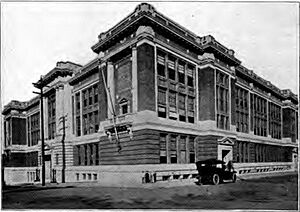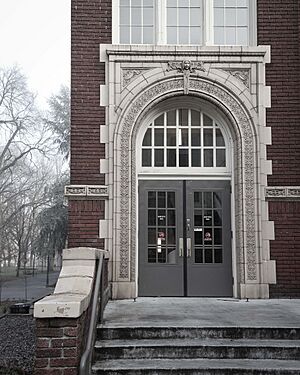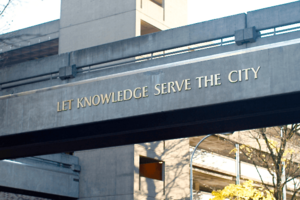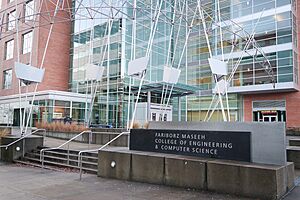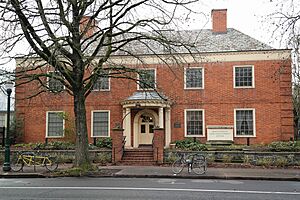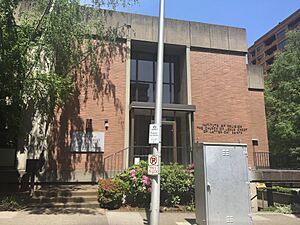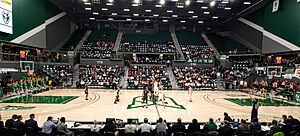Portland State University facts for kids
Portland State University (PSU) is a public university in Portland, Oregon. It was started in 1946 to help soldiers returning from World War II get an education. Over the years, it grew into a four-year college and became a university in 1969. It's one of the main public universities in Oregon located in a big city.
PSU has seven main colleges. Students can choose from 123 different subjects for their first degree and 117 subjects for advanced degrees. In 2023, about 21,000 students attended PSU. The university's sports teams are called the Portland State Vikings, and their colors are green and white. They compete in NCAA Division I sports.
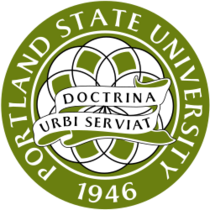 |
|
|
Former names
|
Vanport Extension Center (1946–1955) Portland State College (1955–1969) |
|---|---|
| Motto | Doctrina urbi serviat (Latin) |
|
Motto in English
|
"Let knowledge serve the city" |
| Type | Public research university |
| Established | 1946 |
| Accreditation | NWCCU |
|
Academic affiliations
|
|
| Endowment | $98 million (2023) |
| President | Ann Cudd |
|
Academic staff
|
1,951 (fall 2023) |
|
Total staff
|
5,232 (fall 2023) |
| Students | 21,040 (fall 2023) |
| Undergraduates | 16,423 (fall 2023) |
| Postgraduates | 4,617 (fall 2023) |
| Location |
,
,
United States
45°30′46″N 122°41′07″W / 45.51278°N 122.68528°W |
| Campus | Large city, 50 acres (20 ha) |
| Newspaper | Portland State Vanguard |
| Colors | Green and white |
| Nickname | Vikings |
|
Sporting affiliations
|
NCAA Division I FCS - Big Sky |
| Mascot | Victor E. Viking |
 |
|
Contents
History of Portland State University
How PSU Started (1946–1964)
Portland State University began in June 1946. It was first called the Vanport Extension Center. Stephen Edward Epler started it to help World War II veterans get a college education. Many veterans were returning home and needed more schooling.
The first classes were held in a junior high school in Vanport. Because it was near the Columbia River, people nicknamed it "The U by the Slough." In the first summer, 221 students attended. By the fall, over 1,410 students had signed up. The school used buildings that were no longer needed in Vanport. It also used classrooms in other high schools and university buildings in Portland.
In 1948, a big flood hit Vanport. The college refused to close, earning the nickname "the college that wouldn't die." After the flood, the school moved to different temporary spots. In 1953, it finally moved to downtown Portland. It took over the old Lincoln High School buildings, including Lincoln Hall.
In 1955, the center changed its name to Portland State College. This showed it was now a four-year college that could give out degrees. Stephen Epler, who started the school, left around this time. By 1956, fewer veterans were attending, and the college continued to grow.
Growing and Developing (1965–2000)
For many years, Portland State's growth was limited. This was because of an old rule that said public universities in Oregon shouldn't offer the same programs. However, PSU still added more advanced study programs in the 1960s and 1970s. In 1969, it officially became Portland State University.
In 1993, PSU changed how its undergraduate students learned. They started a new program called University Studies. This program focused on different subjects working together. It included special courses for freshmen and sophomores. It also had "junior cluster" courses and a "senior capstone" project. The capstone project involved students working on a community project. This new way of learning got national attention. U.S. News & World Report even called it a "Program to Look For." In 1995, the university honored Stephen Epler for his important role in starting the school.
Recent Years (2001–Present)
In 2003, Portland State began offering degrees in Black Studies. That same year, it opened a center for Native American students. In 2004, the College of Engineering and Computer Science was renamed after a former student, Fariborz Maseeh.
In 2020, the university decided that its campus police would no longer carry guns on patrol. This decision was made after protests and a past incident. If there was a dangerous situation, the Portland police would respond instead. However, this policy changed again, and by early 2023, campus police started carrying weapons once more.
Leaders of Portland State
Here are some of the important leaders who have guided the university:
- Stephen E. Epler (Vanport Extension Center), 1946–1952
- John F. Cramer, 1955–1958
- Brandford P. Millar, 1959–1968
- Gregory B. Wolfe, 1968–1974
- Joseph C. Blumel, 1974–1986
- Natale A. Sicuro, 1986–1988
- Roger N. Edgington (Interim President), 1988–1990
- Judith A. Ramaley, 1990–1997
- Daniel O. Bernstine, 1997–2007
- Michael F. Reardon (Interim President), 2007–2008
- Wim Wiewel, 2008–2017
- Rahmat Shoureshi, 2017–2019
- Stephen Percy, 2020–2023
- Ann Cudd, 2023–present
What Students Learn at PSU
Portland State offers many different subjects for students. There are 123 undergraduate degrees and 117 postgraduate degrees. The university has added more advanced degree programs over time. This shows it has grown from a liberal arts college to a research university.
In 2006, PSU started its first online degree program. Students can now earn a bachelor's degree in criminology and criminal justice online. In the 2014–15 school year, PSU awarded over 6,000 degrees. This included bachelor's, master's, and doctoral degrees.
How to Get Into PSU
Getting into Portland State University is not too difficult. In 2012, about 95% of applicants were accepted. By 2015, the acceptance rate was around 61%. PSU also has agreements with local community colleges. This allows students to easily transfer to PSU after completing two years at a community college.
Colleges and Schools at PSU
Portland State University has nine main academic areas:
- College of Liberal Arts and Sciences
- School of Business Administration
- College of Education
- OHSU-PSU School of Public Health
- Maseeh College of Engineering and Computer Science
- College of the Arts
- School of Social Work
- College of Urban and Public Affairs
- University Honors College
PSU also offers short courses for professionals. These courses help people learn new skills for their jobs.
University Studies Program
In 1993, PSU started a special program for all undergraduate students called University Studies. This program is unique to PSU. It helps students connect different subjects and think critically.
The program starts with Freshman Inquiry courses. These classes are interactive and explore topics from many different angles. Then come Sophomore Inquiry courses, which focus on communication, group discussions, and research.
As students become juniors, they take Upper Division Cluster Courses. These courses are more detailed and relate to their chosen major. Finally, in their senior year, students complete a six-credit senior capstone project. This project combines classroom learning with community work. Students often work with local groups on issues like social justice or environmental protection. They usually share their experiences in a public presentation.
This program has been praised by many national organizations. It's known for its new way of teaching college students.
Research at PSU
PSU is known as a university with "higher research activity." The Branford Price Millar Library is the main library on campus. It has over 1.4 million books and many computer labs. The library building is unique because it has a curved glass wall built around a large, old copper beech tree.
The library also has many electronic books, microforms, maps, and audio-visual materials. It is a place where federal government documents are stored.
University Rankings
Portland State University is recognized in various rankings. U.S. News & World Report has listed it as a good research university. The Princeton Review has called PSU one of "The Best 376 Colleges" and a "College With a Conscience."
In 2015, PSU was ranked among the "Most Innovative" colleges in the country. In 2024, Washington Monthly ranked Portland State 124th among national universities. This ranking looks at how much universities help the public good, like social mobility and public service.
PSU's School of Business Administration is also highly ranked. Its Urban & Regional Planning Program is considered one of the best in the nation. Other top programs include Rehabilitation Counseling, Social Work, and the Graduate School of Education. The university is also known for its undergraduate engineering programs.
Campus Life at PSU
Most of the PSU campus is in downtown Portland, covering about 50 acres. It's located near the West Hills. The main campus buildings are along SW Broadway, including Lincoln Hall and Smith Memorial Student Union. Many of these buildings are connected by tunnels and skybridges. This allows students to move between buildings without going outside.
The university's South Park Blocks are green spaces that run through the campus. The campus is also close to popular spots like Pioneer Courthouse Square and the Portland Art Museum.
In 2010, PSU opened a new Student Rec Center. This building has an aquatics center, a climbing wall, sports courts, and a fitness area. It's located in the Urban Center, which also has the university bookstore and restaurants. The Portland Streetcar runs through this area.
PSU also has the 5th Avenue Cinema, which is one of the few movie theaters in the United States run by students.
Where Students Live
PSU has ten residence halls where about 3,000 students live. Some of the largest buildings include University Pointe, a sixteen-story apartment building, and Ondine, a fifteen-story high rise.
Student Groups
There are several fraternities and sororities on campus. These are social groups for students. They are part of a student-run group called "Greek Life."
Art on Campus
Portland State University has many public art pieces around campus. These artworks are by famous local and international artists.
Being Green at PSU
The university works hard to make its buildings environmentally friendly. Many buildings on campus are "LEED-certified," meaning they meet high standards for being green. PSU has been named one of the most eco-friendly universities in the U.S. It's also known for students using public transportation and bicycles. In 2013, PSU was ranked among America's most bike-friendly universities.
Outside Shattuck Hall, there's a special garden called the Shattuck Hall Ecological Learning Plaza. It has green walls, solar panels, and special pavement that lets water soak through.
Student Life and Activities
Portland State is different from other Oregon universities because it's in a city. It attracts students who are a bit older; in 2010–2011, the average age of an undergraduate student was 26. Some programs even offer only night classes.
The student government at PSU is called the Associated Students of Portland State University (ASPSU). Students elect a President, Vice President, and a Student Senate.
Student Publications
PSU has a student-run newspaper called the Portland State Vanguard, which started in 1946. Students also run a radio station, KPSU, and a television station, PSU TV. The Portland Review is a literary magazine published by students.
Student Support Centers
The university has several centers to help students. These include a Women's Resources center, a Disability Resources center, a Resource Center for Students with Children, a Queer Resource Center for LGBT students, and a Veteran's Resource Center.
Getting Around Campus
PSU has several parking garages for cars. The campus is also well-connected by public transportation. TriMet buses and the MAX light rail system serve the university.
Many students at PSU also ride bicycles. The university is known for being very bike-friendly.
Religious Services
There are two Christian churches on PSU's campus. St. Michael the Archangel Catholic Church is home to the Portland State Newman Center. The Church of Jesus Christ of Latter-day Saints also has an Institute of Religion on campus. Other clubs for Christian, Muslim, and Jewish students meet at the university.
Sports at PSU
Portland State competes in NCAA Division I sports. These include football, basketball, volleyball, golf, soccer, tennis, softball, track and field, and cross country. The football team plays in Division I FCS. PSU is part of the Big Sky Conference.
Before joining Division I, PSU won national championships in women's volleyball and wrestling. The university also has over 30 student-run club sports, like rugby, ice hockey, and lacrosse.
Portland State's colors are green and white. Their mascot is Victor E. Viking. Football home games are held at Hillsboro Stadium, and basketball games are played on campus at the Viking Pavilion.
Famous People from PSU
Notable Alumni
{{gallery mode="center" height="225px" style="text-align:center" caption="Notable Portland State alumni:" styles="text-align:center"} Image:Keynote speaker Margaret Carter (8113364377).jpg|Margaret Carter, politician Image:ShoDozonoMay7Cropped.JPG|Sho Dozono, entrepreneur Image:Evan Jager 2016.jpg|Evan Jager, distance runner Image:Travis Knight (30000495292).jpg|Travis Knight, animator; president and CEO of Laika Image:Joseph Evan LeBaron.jpg|Joseph LeBaron, former ambassador to the State of Qatar Image:Life Ball 2014 Courtney Love Crop.png|Courtney Love, singer and musician Image:Charles Moose.jpg| Charles Moose, police chief Image:Governor Barbara Roberts.jpg|Barbara Roberts, 34th Governor of Oregon Image:DeShawn Shead 2015.jpg|DeShawn Shead, NFL player (Seattle Seahawks) Image:Esperanza Spalding July 15, 2009.jpg| Esperanza Spalding, musician Image:NancyWilsonHeartMay10.jpg|Nancy Wilson, singer and musician } Many successful people have graduated from Portland State University. These include:
- Government Leaders: Barbara Roberts, who was the Governor of Oregon. Margaret Carter, the first African American woman elected to the Oregon House of Representatives.
- Business Leaders: D. Scott Davis, a former CEO of United Parcel Service. Phil Knight, who co-founded Nike, Inc., was also a professor at PSU. His son, Travis Knight, who is an animator and CEO of Laika, is an alumnus. Carolyn Davidson, who designed the famous Nike swoosh, was a student at PSU.
- Writers and Artists: Poets Michael Dickman and John Sibley Williams. Mike Richardson, who started Dark Horse Comics, also went to PSU.
- Scientists: Ivan Sutherland, a computer scientist who won a major award called the Turing Award. Jill Mikucki, an Antarctic researcher.
- Performers: Four-time Grammy Award-winning jazz musician Esperanza Spalding. Actors Mark Dacascos and Terence Knox. Singer and musician Courtney Love also attended PSU.
- Athletes: Football players like DeShawn Shead and Julius Thomas. Freeman Williams, a basketball player with one of the highest NCAA scores in history.
Notable Teachers and Professors
{{gallery mode="center" height="225px" style="text-align:center" caption="" styles="text-align:center"} Image:PeterBoghossian.PNG|Peter Boghossian, professor of philosophy Image:Paul Collins crop.jpg|Paul Collins, writer and Guggenheim Fellow Image:2014 Pop Conference - Sarah Dougher 01.jpg|Sarah Dougher, musician and women's studies scholar Image:Andrew Hill.jpg|Andrew Hill, pianist and composer Image:Philknightfootball.jpg|Phil Knight, co-founder of Nike Image:Ivan Sutherland at CHM.jpg|Ivan Sutherland, Turing Award-winning computer scientist } Many talented people have taught at Portland State University, including:
- Diana Abu-Jaber – a professor of English and writer.
- Paul Collins – a writer and head of the English department.
- Sarah Dougher – a musician and scholar of women's studies.
- Harrell Fletcher – a professor of art.
- Andrew Hill – a famous jazz pianist and composer.
- Phil Knight – the co-founder of Nike, Inc., who was once an accounting professor.
- Ivan Sutherland – a computer scientist who won the Turing Award.
See also
 In Spanish: Universidad Estatal de Portland para niños
In Spanish: Universidad Estatal de Portland para niños


